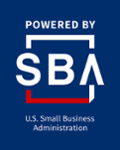GROWTH is a good thing!
Congratulations! Business is booming and you’re bursting at the seams – now what? The key to expansion success is to develop a new and improved business plan that helps you control your growth. If you intend to seek out a formal business loan, your banker will expect to see a formalized plan that demonstrates your ability to take on additional debt.
- Learn more about writing your plan: SBA’s How to Write a Business Plan video
- Brainstorming: Business Model Canvas
- When you’re ready to write in earnest: Business Plan Template
Show Me the Money
The Small Business Administration (SBA) has several loan products offered through traditional bankers that are designed to facilitate business expansion. Banks like these products because the government offers a guarantee that is enticing to the lending agency; this works in your favor, but doesn’t mean you wouldn’t ultimately be responsible for repaying the loan should you default.
- Government Loan Products: SBA Resource Guide (? pdf)
Your personal and business credit scores are also important pieces of data that demonstrate your ability to handle debt and the bank will look at those scores. They will also expect you to have “skin in the game”, your own money or that of your friends and family, typically 20-50% of the total project. Finally, the bank will ask for collateral. For first-time borrowers, that usually will mean establishing a lien against your home; subsequent business loans will take liens against the business as well.
How Do I Know If I’m Bankable?
The bank will look at the financial projections you prepare as part of your business plan. But there are other ways to know in advance whether or not your financial picture will assure the lender that you’re a sound risk. Provided your financial records are current, you can apply three specific ratios to your present situation to determine your “bankability”; Current, Quick, and Debt-to-Worth.
The Financial Literacy course, Profit Mastery, offered through our center three times a year, describes these ratios as follows:
- Current Ratio = Current Assets/Current Liabilities
This ratio measures a company’s ability to pay its bills. Bankers like to see a ratio of 2:1
- Quick Ratio = (Cash + Accounts Receivable)/Current Liabilities
This ratio measures the ability to generate cash. Bankers like to see a ratio of 1:1
- Debt-to-Worth Ratio = Total Liabilities/Net Worth
This ratio measures risk; again, bankers like to see a ratio of 1:1
Falling outside of these ratio criteria doesn’t necessarily mean an automatic “no”, but a weak financial position will definitely impact the size of the loan and its corresponding interest rate. Discovering early on that you have a weak financial position provides you with an opportunity to stage an intervention and do damage control before approaching a lender.
A Few Words About Alternative Financing
There’s been a lot of buzz in recent years about crowdfunding. Sites such as Kickstarter and Indigogo have created overnight success stories. Or have they? Money gleaned from a successful crowdfunding campaign is anything but fast or cheap. Successful ventures may have experienced several failures before finally hitting their goal. There are fees and costs that bite into the booty, and simply preparing a campaign can take several months.
Some rules of thumb:
- Videos should be no longer than 90 seconds
- Start promoting and building your fan-base at least six months in advance
- The sweet spot for goal is $15,000 of which the platform will take a percentage and, remember, your incentives will need to be fulfilled from the pot as well
- Crowdfunding is best leveraged to conduct market research and demonstrate demand than actually financing a project
- Consider breaking projects into smaller pieces and running multiple campaigns
- Service-oriented projects are less likely to be funded than actual products
Final Words
Our consultants are all skilled in helping you visualize your project or expansion. You are encouraged to schedule an appointment, 320-308-4842, to discuss your goals and develop your plan.

Funded in part through a Cooperative Agreement with the U.S. Small Business Administration, Minnesota Department of Employment and Economic Development and regional support partners. All opinions, conclusions or recommendations expressed are those of the author(s) and do not necessarily reflect the program sponsors. Programs are open to the public on a nondiscriminatory basis. Reasonable accommodations for persons with disabilities will be made if requested at least two weeks in advance. Contact Central Region SBDC at 320-308-4842.
